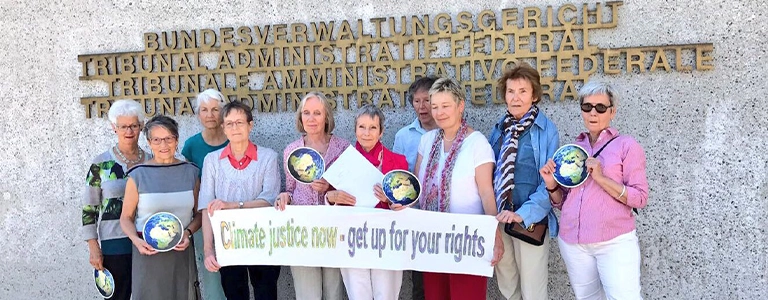Summary
On April 9, 2024, the European Court of Human Rights (ECtHR) issued a landmark judgment in the case of Verein KlimaSeniorinnen Schweiz vs. Switzerland, marking its first major decision on climate change issues. The case, heard by the Grand Chamber of the Court, involved a group of older Swiss women who claimed that Switzerland’s failure to adequately address climate change violated their rights under the European Convention on Human Rights (ECHR).
The Court ruled in favour of the applicant association, finding that by failing to fulfil its positive obligation to take all necessary measures to mitigate climate change, Switzerland had violated the right to respect for private and family life (Article 8 of the Convention). Additionally, the Court found that by inadequately addressing the applicant’s case, Switzerland had breached the right to access to court (Article 6 of the Convention).
The Case Note is also available in Portuguese
Case Background
The Applicants are the Swiss Association KlimaSeniorinnen Schweiz (Senior Women for Climate Switzerland), established under Swiss law to advocate for and implement effective climate protection on behalf of its more than 2,000 members, the majority of whom are women over 70, and four individual women, each a member of the association and over 80 years old.
Initial Proceedings in Switzerland
In November 2016, applicants requested Swiss authorities to address climate protection issues under section 25a of the Swiss Federal Law on administrative procedure, aiming to meet the 2030 Paris climate agreement goals. In April 2017, the Federal Department of the Environment declared their request inadmissible, stating it pursued general public interests and lacked direct impact on their rights.
The applicants appealed to the Federal Administrative Court in November 2018, which dismissed their appeal, finding insufficient differentiation in their rights affected by climate change from those of the general population. Their subsequent appeal to the Federal Supreme Court in January 2019 was dismissed in May 2020. The court ruled that individual applicants did not show enough direct impact on their constitutional rights to life or their right to respect for private and family life to justify legal protection under section 25a. The standing of the applicant association remained unresolved.
Initiation of proceedings before the ECtHR
On November 26, 2020, the applicants filed an application to the European Court of Human Rights (ECtHR).1
The applicants argued against the Swiss authorities for failing to adequately mitigate the adverse effects of climate change, particularly the climate-aggravated heatwaves, on their lives, living conditions, and health. They alleged violations of their rights under Articles 2 (right to life) and 8 (respect for private and family life) of the European Convention on Human Rights (ECHR), asserting that Switzerland had not fulfilled its obligations to effectively protect life and ensure respect for their private and family life. The applicants criticised the State for not enacting appropriate legislation and sufficient measures to meet international climate change targets.
Additionally, they claimed they were denied access to a court under Article 6 § 1, contending that domestic courts had inadequately addressed their requests and issued arbitrary decisions regarding the State’s inaction on climate change’s adverse effects.
The case was given priority by the Chamber, which granted it expedited treatment under Rule 41 of the Rules of the Court.
In April 2022, the original Chamber handling the case transferred jurisdiction to the Grand Chamber. To ensure the efficient administration of justice, the President of the Court decided that this case should be assigned to the same Grand Chamber2 composition that had handled two other significant climate-related cases – Duarte Agostinho et al vs. Portugal and 32 Member States3 and Carême v. France4.
Although the cases were not joined due to their distinct challenges regarding state responsibilities under the ECHR and the staggered hearings, they were all adjudicated by the same Grand Chamber composition.
On April 9, 2024, the Grand Chamber declared the complaints in the Duarte Agostinho and Carême cases inadmissible.5 However, the Court deemed the KlimaSeniorinnen claim admissible and issued a judgment after a thorough review of the substantive issues. In its judgment, the Court ruled in favour of the applicant association, finding that Switzerland had violated Article 8 by failing to fulfil its positive obligation to take all necessary measures to mitigate climate change. Additionally, the Court found that Switzerland had breached Article 6 by inadequately considering the applicant’s case.
In its landmark inaugural judgment on climate change, the ECtHR thoroughly outlined its approach to addressing this critical issue. The Court dedicated a substantial portion of its assessment to clarifying its methodology for climate change cases. This included establishing new guidelines on standing and detailing the unique considerations that must be addressed when adjudicating the impacts of climate change on human rights.
Preliminary observations on climate change
The Grand Chamber began its evaluation with key preliminary observations on climate change [410-422], recognising it as one of the most urgent global issues, primarily caused by the accumulation of greenhouse gases (GHG) in the atmosphere, which leads to a range of complex and detrimental effects on both human communities and the environment. The Court clarified its role under Article 19 of the ECHR, emphasising that although it is responsible for ensuring adherence to Convention obligations, addressing climate change primarily requires legislative and executive actions beyond the Court’s scope.
The Court further highlighted past deficiencies in climate change mitigation efforts. It stressed that scientifically validated risks to human rights must be incorporated into its enforcement of Convention obligations. The Court observed that climate change cases pose unprecedented legal challenges, which differ significantly from those in traditional environmental law. While earlier cases often dealt with specific sources of environmental harm, climate change involves broader and more complex issues. Recognising these distinctions, the ECtHR concluded that applying existing environmental case law directly would be inadequate. Therefore, the Court aims to refine its approach to more effectively address the multifaceted legal and human rights implications arising from climate change.
Building on its previous observations, the Court now draws on principles from environmental law to develop a more refined approach suited to the complexities of climate change. It emphasised the importance of evolving scientific evidence and underscored the connection between climate change impacts and various human rights, advocating for a responsive legal framework under the ECHR.
The ECtHR also recognised the intergenerational consequences of climate change, noting that inaction today will disproportionately impact future generations. This viewpoint aligns with states’ obligations under the United Nations Framework Convention on Climate Change (UNFCCC) to protect the climate system for both present and future generations.
Considerations relevant to climate change cases
The Court then turned to examining overarching considerations relevant to climate change cases [423-457].
It identified causation as a pivotal issue in human rights complaints against States concerning climate change, addressing several distinct dimensions critical to victim status and State’s obligations under the ECHR. The Court outlined these dimensions as follows:
- The scientific link between GHG emissions and their accumulation in the atmosphere, which leads to various climate change phenomena.
- The connection between the adverse effects of climate change and their impact on both present and future enjoyment of human rights.
- The individual-level links between the alleged harm or risk faced by specific individuals or groups and the actions or omissions of State authorities targeted by human rights complaints.
- The attribution of responsibility for climate change effects to a State, considering the multiple actors involved in contributing to GHG emissions.
The ECtHR also addressed the evidential standards necessary for climate change cases, emphasising the need for proof ‘beyond reasonable doubt’. Claims of a State’s failure to adhere to domestic rules or environmental standards alone were considered insufficient to demonstrate a violation of Convention rights. The Court underscored the need to evaluate whether the situation in question contravened relevant domestic laws and recognised the importance of international environmental pollution standards in assessing impacts on individual rights.
To inform its evaluation, the Court extensively referenced reports from international organisations, particularly the scientific guidance from the Intergovernmental Panel on Climate Change (IPCC) on climate change impacts, future risks, and mitigation strategies.
Moving forward, the Court recognised the robust evidence from these international bodies, which underscores anthropogenic climate change as a serious present and future threat to human rights protected under the Convention. It highlighted the urgent need for global action to limit temperature increases to 1.5°C above pre-industrial levels to mitigate these risks and noted that current global mitigation efforts are inadequate.
The Court addressed the complexities of causation in climate change cases, distinguishing these from local pollution sources. It observed that climate change often involves indirect and tenuous causal links between State actions or omissions and resulting harm or risk. The Court highlighted States’ positive obligations to mitigate risks to individuals, noting that failures to meet these duties increase risks, though individual exposures may vary based on specific circumstances.
On the issue of State responsibility, the Court reaffirmed the principle of common but differentiated responsibilities, as outlined in international agreements like the UNFCCC. It rejected arguments that minimised State responsibility based on the “drop in the ocean” rationale. The Court clarified that State responsibility does not depend on proving that harm would not have occurred “but for” specific actions or omissions. Instead, States are accountable if their failure to take reasonable measures could have realistically altered outcomes or mitigated harm. This aligns with the UNFCCC’s mandate for States to anticipate, prevent, and minimise the causes and effects of climate change.
Criteria for determining admissibility and standing
The Court then turned to establishing criteria for determining admissibility and standing, outlining general principles related to victim status. It acknowledged the close relationship between victim status and the applicability of relevant Convention provisions. Consequently, the Court integrated its assessment of individual victim status and the standing of associations with the applicability of Articles 2 and 8 of the Convention.
Individual victim status [478-488] – the Court recognised substantial scientific evidence showing that climate change exacerbates illness and mortality, particularly among vulnerable populations. It highlighted the potential for irreversible and severe consequences of climate change if decisive state action to reduce GHG emissions is not taken. Given that States are significant contributors to anthropogenic climate change, they committed to mitigation and adaptation measures according to their differentiated responsibilities and capabilities. These factors suggest a legally significant causal link between state actions or omissions on climate change and harm to individuals.
The Court’s main challenge was evaluating claims of harm related to state actions or omissions that impact individuals’ rights under Articles 2 (right to life) and 8 (respect for private and family life) of the Convention. The Court emphasised that its jurisprudence demands a direct effect of the alleged action or omission on the applicant, or a significant risk of such an effect. However, in climate change cases, where the impact extends to nearly everyone, establishing victim status under the Convention becomes particularly difficult. The Court clarified that its existing case law, which allows ‘potential’ victims to claim status based on a legitimate personal interest, could not be broadly applied in this context. Doing so might encompass nearly everyone, thereby failing to provide an effective limiting criterion.
Therefore, to address the unique challenges posed by climate change and ensure effective protection of Convention rights, applicants alleging harm or risk from state failures to combat climate change must demonstrate personal and direct impact from governmental actions or inactions. This approach excludes general public-interest complaints (actio popularis6) and requires meeting two stringent criteria: (1) significant exposure to the adverse effects of climate change and (2) a compelling need for individual protection, especially where mitigation measures are inadequate or non-existent [487].
Standing of associations (locus standi) [489-503] – the Court emphasised their crucial role in advocating for the rights of affected individuals, a principle supported by previous case law and international instruments such as the Aarhus Convention. Although the Aarhus Convention does not explicitly address climate change litigation, there is increasing recognition among member states that environmental associations may be granted standing to pursue such cases through national legislation or established case law. This approach reflects the global importance of climate change and the principles of intergenerational equity, fostering collective action for comprehensive environmental protection.
The Court outlined three criteria for associations seeking to file claims on behalf of individuals against a member State’s alleged failure to address climate change impacts: (1) lawful establishment or recognised standing within the relevant jurisdiction, (2) a dedicated purpose focused on defending human rights against climate-related threats, and (3) the capacity to genuinely represent affected individuals under the Convention.
In evaluating an association’s standing, the Court takes into account factors such as non-profit status, activities within the jurisdiction, membership composition, representativeness, governance transparency, and the interests of justice. Importantly, an association’s standing does not necessitate that individual members fulfil the victim-status criteria applicable to individuals in climate change cases [502]. Additionally, the Court may consider whether affected individuals have sought recourse through domestic courts in related matters, ensuring comprehensive judicial review.
In applying these considerations to the case, the Court determined (with 16 votes in favour and 1 against) that the applicant association, KlimaSeniorinnen Schweiz, met the standing criteria under Article 8 of the Convention. However, it unanimously found that the four individual applicants did not fulfil the victim-status criteria under Article 34 (individual applications). Although the individuals were vulnerable to the effects of climate change, the evidence did not demonstrate that they were experiencing significant immediate impacts that warranted urgent protection.
Considering that Article 8 was deemed applicable to the complaint filed by the applicant association, the Court chose not to evaluate the case from the perspective of Article 2. However, it observed that the principles established under Article 2 are largely similar to those developed under Article 8, and that together they provide a useful basis for defining the overall approach to be applied in the climate-change context under both provisions.
Merits
In evaluating the merits of the case, the Court focused on the positive obligations of States in relation to climate change [541-554]. It acknowledged that while States have some margin of appreciation in determining their climate goals and policies, this margin is constrained by the urgent nature of the climate crisis and the widespread consensus on the necessity for effective action. Despite this flexibility, States are primarily responsible for implementing practical and effective measures to address both current and potential irreversible effects of climate change. This responsibility, which is intricately linked to human rights under the Convention, must be aligned with international commitments, such as those outlined in the Paris Agreement, as well as with scientific guidance from organisations like the IPCC.
In assessing whether a State has appropriately exercised its margin of appreciation, the Court considers factors such as the establishment of clear timelines for carbon neutrality, intermediate emission reduction targets, and evidence of compliance. The Court emphasised the necessity for timely and consistent action in developing and enforcing relevant legislation [550].
It also noted that deficiencies in a single area do not necessarily indicate a breach of the State’s margin of appreciation [551]. Effective climate protection requires not only addressing direct impacts but also implementing adaptation measures to mitigate severe consequences and ensuring procedural safeguards for public access to information and participation in decision-making [554].
Applying these principles to the current case, the Court identified significant shortcomings in Switzerland’s domestic regulatory framework. The absence of quantified national GHG emission limits and the failure to meet previous reduction targets were deemed violations of the State’s positive obligations under Article 8, exceeding the permissible margin of appreciation [573]. Ultimately, the Court concluded (with 16 votes in favour and 1 against) that Switzerland had violated Article 8 of the Convention.
Article 6 § 1
Regarding the allegation of a violation of Article 6 § 1 concerning access to court, the Court determined that the Swiss courts’ dismissals of the case were not adequately justified as they failed to address the merits of the case or consider the compelling scientific evidence related to climate change. This disregard, combined with the lack of alternative national legal remedies, led the Court to conclude that there was a violation of Article 6 § 1.
Execution of the Judgment
Given the complexity of the issues, the Court chose not to specify the exact measures required for compliance. Instead, it determined that a declaratory judgment was adequate. The Court concluded that Switzerland, with the support of the Committee of Ministers, is in a better position to identify and implement the necessary actions. Consequently, the Committee of Ministers should oversee the adoption of measures to ensure that domestic authorities meet the Convention’s requirements, as outlined in the judgment [657].
Concluding observations
This landmark judgment by the European Court of Human Rights marks an important development at the intersection of human rights and environmental law. The Court recognises climate change as a pressing global issue and affirms that both mitigation and adaptation efforts can fall under Articles 2 and 8 of the European Convention on Human Rights.
The Court addresses the complex legal challenges posed by climate change, including issues of causation and the necessity of intergenerational equity in managing climate-related human rights impacts. These considerations influence the Court’s approach to shaping an adaptable legal framework for adjudicating climate change cases under the Convention.
The judgment introduces a novel approach to admissibility (standing) by establishing that individuals can only claim standing in climate cases if they face severe exposure and an urgent need for protection—a threshold not met by the applicants in this case. Conversely, the Court’s decision represents a notable shift by allowing associations to gain standing without requiring individual members to meet victim-status criteria, thus enhancing access to justice for climate-related claims.
This decision sets a robust precedent for evaluating climate change claims and clarifies the Court’s expectations for state accountability in addressing climate impacts. It is anticipated to encourage domestic litigation to fill gaps in state action, while recognising that the Court itself is not suited to manage the intricate details of climate change mitigation.
Footnotes
¹ Verein KlimaSeniorinnen Schweiz vs. Switzerland [GC] 53600/20.
² The ECtHR Grand Chamber comprises 17 judges, including the President of the Court, the Vice-Presidents, the Presidents of the Sections and the national judge; the remaining judges are designated by drawing lots.
³ Duarte Agostinho and Others vs. Portugal and 32 Others (dec.) [GC] – 39371/20, Decision of April 9, 2024 [GC]. The case involved six young Portuguese nationals who challenged multiple European states for their inadequate actions in mitigating climate change, arguing that this negligence endangered their future and violated their human rights.
⁴ Carême vs. France (dec.) [GC] – 7189/21, Decision of April 9, 2024 [GC]. The case was brought by the mayor of a French seaside town, Grande Synthe, highlighting the local impacts of rising sea levels and coastal erosion exacerbated by climate change. The claimant argued that France has taken insufficient steps to prevent climate change.
⁵ In Duarte Agostinho et al vs. Portugal and 32 Member States, the Court found that territorial jurisdiction could be established only with respect to Portugal, while no jurisdiction could be established with respect to the other States in this case. However, the Court eventually found the complaint against Portugal to be inadmissible since the claimants did not exhaust domestic remedies before bringing the claim to the ECtHR. As for Carême vs. France, the Court found the case inadmissible, since the claimant did not meet the victim status under Article 34 of the Convention, as he no longer lives in Grande Synthe, nor for the time being in France, and no longer has any sufficiently relevant link with Grande Synthe.
⁶ The term refers to actions taken to obtain a remedy by a person or a group in the name of the general public. Those persons or groups are neither themselves victims of a violation nor have they been authorised to represent any victims or potential victims. The European Convention on Human Rights excludes such type of complaints.
Author: Natalie Rosen




